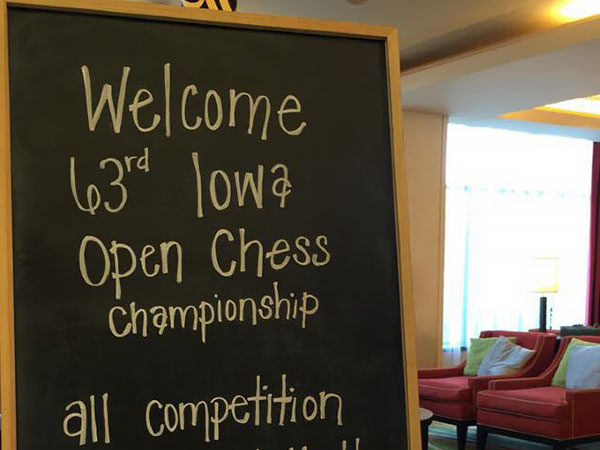Gareyev runs the table

The 63rd edition of the Iowa Open once again took place at the Mariott Hotel and Conference Center in Coralville.
Located in the southeast corner of the state, Coralville gives an impression of a typical American suburbia with its giant shopping mall (largest in the state), hotels and chain restaurants. Yet, there's a distinct feature in the otherwise standard layout, given by a man-made lake, called the Coralville Reservoir. In 1958 U.S. Army Corps of Engineers built a dam along the Iowa River to alleviate the annual flooding.
Iowa is big on rivers. The three borders, southern (the Des Moines River), eastern (The Mississippi) and western (The Missouri and higher up north, the Big Sioux River) borders are almost entirely made by rivers, and there are nice lakes along the northern border with Minnesota. The abundance of water makes Iowa an ideal farming state. The food grown in Iowa would probably be enough to sustain the entire population of the United States.

Aerial view of the Coralville Reservoir
The Mariott in Coralville, as any building does, has two sides to it. From the front, it looks like, well, nothing special.

But wait until you see the other side...

Over there the visitors find themselves looking at a nice clean pond with walkways around and across it, guarding a well-preserved wetland habitat.
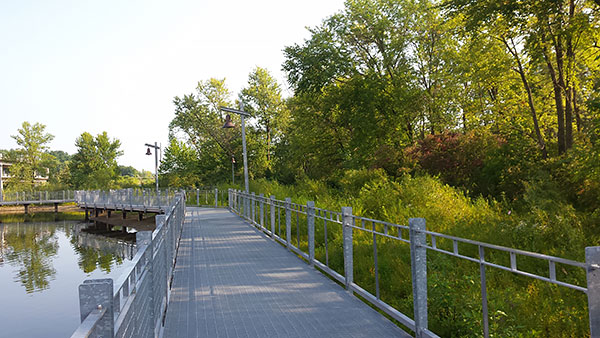
The walkways provide scenice and highly enjoyable strolls
This area provides a much-needed space for a quiet walk between games. The Conference Center is located at the far of the hotel, and I always prefer to take the pond walkway there, rather then negotiate the winding corridor inside the building.

The playing hall provided ample space for 123 participants, 83 of then in the Open Section. The event was ably run by a team of local enthusiasts, Mark Capron, Eric Vigil and Bill Broich. Thank you, guys!
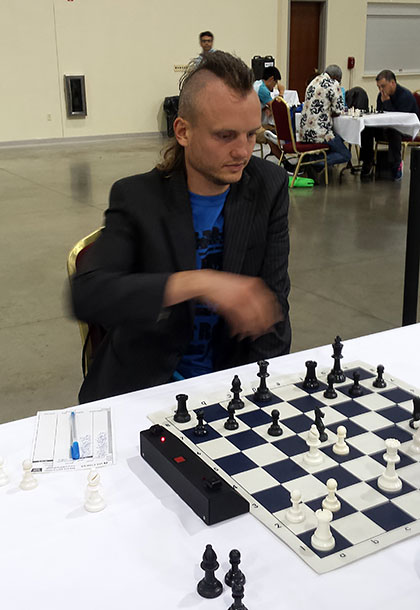
Timur Gareev had a superb tournament with a perfect 5.0/5
As the reader can see the top seed Timur Gareyev (many sources have Timur's last name as “Gareev”, which is phonetically less accurate) fully redeemed himself for a last-round loss at the Twin Ports Open by simply running the table in Coralville. His last round win over Minnesota IM Sean Nagle was a smooth affair. Unfortunately I wasn't able to get a hold of the game score, so the reader will have to take my word for granted. Instead I would like to present another Gareyev win, courtesy of his gracious opponent, Dr. Okey Iwu.

[Event "63. Iowa Open"] [Site "Coralville, IA USA"] [Date "2017.08.19"] [Round "3"] [White "Gareyev, Timur"] [Black "Iwu, Okechukwu N"] [Result "1-0"] [ECO "D15"] [Annotator "Iwu"] [PlyCount "67"] [EventDate "2017.08.19"] {My first game against GM Gareyev. We had both taken part in the Twin Ports Open, the week prior, but I did not play well enough there to earn the right to a game against him :-). I had decided before this tournament to avoid specific preparation for individual games, and in furtherance of that goal, only knew who I was playing 3 minutes before round time!} 1. d4 d5 2. c4 c6 3. Nf3 Nf6 4. Nc3 dxc4 5. e3 {Alekhine's variation.} b5 6. a4 b4 7. Ne2 $5 { I had never seen this move before the game. Afterwards, I found that Timur had played it during a rapid game in Hawaii a few years ago, Gareyev-Kojima, Hawaii 2015, a rather entertaining game, actually. Staring at the position, I tried to figure out the pros and cons of this move, compared to the more usual 7. Na2 and 7. Nb1 approaches.} a5 $6 {I think this misses the mark. Black should be focusing energy on developing pieces, usually with an eye towards ... c5, while White works to recoup his pawn. The text move secures b4, allowing a more "harmonious" ...Ba6, and prevents White from playing a4-a5 himself. However, it is not clear at this point that Black wants his bishop on a6, and a4-a5 does not need to be feared yet. A better approach would seem to be immediately going for ...e6, ...Nbd7, and ...Be7 or ...c5, depending on circumstances. As my friend Denton Dykes would say, "Do what you have to do, before you do what you want to do!"} 8. Nf4 Ba6 {Consistent, but not great.} 9. Ne5 e6 10. Qf3 {Threatening fire and brimstone! Besides the obvious threat to c6, f7 is suddenly looking more tender. Fearing ghosts, I played:} Ra7 $6 { Consistent with my apparent goal of misplacing my pieces :-)} (10... Qc7 $142 { Dealing with both threats in a way that does not misplace pieces, and also fights for the e5 and c5 squares.}) (10... c3 $5) 11. Bxc4 Bxc4 12. Nxc4 Be7 13. O-O O-O {[#] Ok, here, I thought I was doing Ok, just a normal opening disadvantage as Black against a strong GM. Then came:} 14. e4 $5 {Timur is planning to crush me like a bug! I needed to find something to change the trend of the game. So, I held my breath, and plunged into:} Qxd4 $1 15. Be3 Qxc4 16. Bxa7 Qxe4 (16... Nbd7 $1 {Looks even better. in hindsight. Getting the knight into action should take priority over half-opening the e-file for White's rooks ;-)}) 17. Qxe4 Nxe4 18. Rac1 {A critical moment for me. I need to get my remaining pieces into the game, but spy a "great" idea. Somehow, I refused to see that Nf4-d3 was even a possibility in the lines I looked at. So, instead of following a plan such as ...c5, ...Nd7, with ...Nd2-b3 thrown in, I took the opportunity to help White reposition his minors to great squares:} Bg5 $2 19. Be3 {Ugh!} Bf6 (19... e5 {My initial intention. When we got here, I saw: } 20. Nd3 Bxe3 21. fxe3 f6 22. Nc5 $1 $18) 20. Nd3 $16 {So, White's position is stabilized, and I am still playing with only half my pieces. Timur proceeds to do what GMs are supposed to do to NMs ;-)} Rd8 21. Rfd1 Rd5 22. Ba7 Nd7 23. Rxc6 g5 24. Rcc1 Bd4 $4 25. Bxd4 (25. Nxb4 $1 $18) 25... Rxd4 26. f3 Nef6 27. Nf2 Rf4 28. Ne4 Rf5 29. Rc8+ Kg7 30. Rc7 Ne5 31. Nd6 Rf4 32. Rc5 Nd5 33. Rxa5 Ne3 {Conveniently forgetting my g-pawn is undefended.} 34. Re1 (34. Re1 N5c4 35. Rxg5+ Kf6 36. Rc5 $18) 1-0
The videos on this DVD give White a repertoire with concrete variations against all main lines Black can play and also show the typical strategic and tactical ideas of the Slav and the hidden subtleties of the position.
Accompanying Dr. Iwu on the road trip were the “Dane Brothers”...
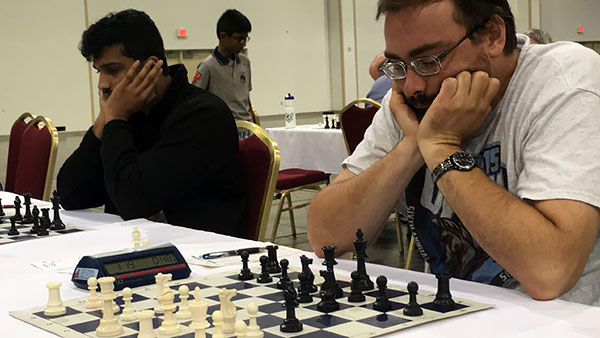
Dane Mattson coming in from Wisconsin finished with 3.0/5

Dane Zagar
...who were happy to be relieved of their organizing duties at the Twin Ports Open just a week before. One of them I met early in the tournament.

[Event "Iowa Open"] [Site "?"] [Date "2017.08.19"] [Round "2"] [White "Zagar, Dane"] [Black "Yermolinsky, Alex"] [Result "0-1"] [ECO "D86"] [Annotator "Yermo"] [PlyCount "54"] [EventDate "2017.??.??"] 1. d4 Nf6 2. c4 g6 {Facing Dane Zagar, a friend of Dane Mattson and the tournament director of the Twin Ports Open, the tournament I played a weekend before, I figured he wouldn't have much of a chance to brush up on the vast theory in the Grunfeld.} 3. Nc3 d5 4. cxd5 Nxd5 5. e4 Nxc3 6. bxc3 Bg7 7. Bc4 O-O 8. Ne2 b6 {Normally, I stay away from this risky move,} ({instead, relying on} 8... Qd7) 9. O-O {Indeed, he didn't spend much time on this obvious, yet not the most critical, move.} (9. h4 $1 {is known to be strong.}) 9... Bb7 10. f3 c5 (10... Nc6 11. Be3 Na5 12. Bd3 Qd7 {would be getting back to my old garbagey line.}) 11. g4 $6 {[#] I bet no one ever thought of this move.} (11. Be3 cxd4 12. cxd4 Nc6 13. Rc1 Rc8 14. Qd2 e6 15. Rfd1 Qd6 $14) 11... Nc6 12. Be3 cxd4 13. cxd4 Rc8 14. Bb5 $6 {Already here Dane began to entertain an idea of a typical exchange sac.} (14. Rc1 Na5 15. Bd3 Rxc1 16. Qxc1 Nc6 $11) 14... a6 15. Ba4 ({Is too late for White to switch to usual positional tracks:} 15. Bxc6 Bxc6 16. a4 b5 17. d5 Bd7 18. axb5 Bxa1 19. Qxa1 Bxb5 20. Bh6 f6 21. Bxf8 Bxe2 22. Rf2 Qb6 23. Bxe7 Bxf3 $17) 15... Na5 16. d5 $5 {Not looking back!} ({ Same applies here: White can longer continue in a normal fashion,} 16. Rc1 Nc4 17. Bf4 b5 18. Bb3 Qb6 $15) 16... b5 17. Bb3 Nxb3 18. axb3 e6 $1 {[#] The best practical decision.} (18... Bxa1 19. Qxa1 f6 20. Nd4 Qd6 21. Rf2 Qe5 22. Qe1 $44) 19. dxe6 $2 ({I was confident White's positional compensation wouldn't be that overwhelming after} 19. Bd4 exd5 20. Bxg7 Kxg7 21. Qd4+ Kg8 22. e5 Re8 { Still, that was the way to go.}) 19... Bxa1 $1 {Only now!} (19... fxe6 20. Bd4 e5 {favors Black as well.}) 20. Qxa1 (20. exf7+ Rxf7 21. Qxa1 Qd3 {is a nice and simple double attack.}) 20... fxe6 21. Nd4 ({In case of} 21. Nf4 Rc6 22. Qe5 Qf6 {beats it off.}) 21... Qf6 22. g5 Qe7 23. e5 {That's exactly where I wanted the white pawns to go.} ({Although,} 23. b4 e5 {didn't look too promising for White either.}) 23... Rcd8 24. b4 $2 $138 Qxb4 25. Qa2 Rxd4 26. Qxe6+ Kh8 27. Qb6 Rg4+ 0-1
As usual, my tournament came down to the last game, where a win was needed to get a prize. My opponent, Missouri IM Michael Brooks, was coming off a tough game against Nagle, which was eventually drawn.
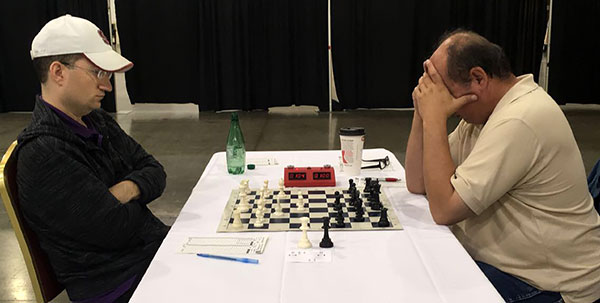
IM Sean Nagle facing IM Michael Brooks
The same result in round 4 was registered in a tough battle between Number Two seed, Priyad Kannappan and NM Valeriy Kosokin, who originally hails from Uzbekistan, which makes him Gareyev's compatriot.
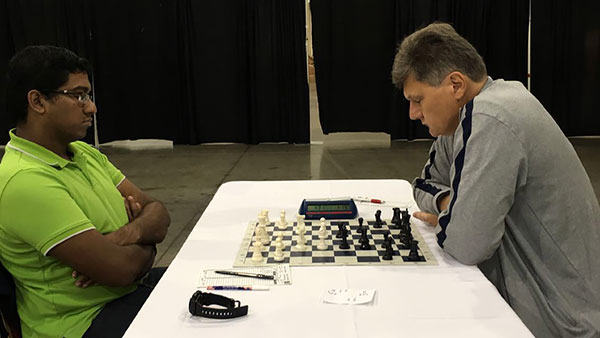
Priyad Kannappan and NM Valeriy Kosokin
In the previous editions of the Iowa Open I couldn't get by those guys, losing to Kosokin in 2015 and to Brooks in 2016. I welcomed a chance at redemption, and it turned out to be quite a nervy affair.

[Event "Iowa Open"] [Site "?"] [Date "2017.08.20"] [Round "5"] [White "Yermolinsky, Alex"] [Black "Brooks, Michael"] [Result "1-0"] [ECO "B06"] [Annotator "Yermo"] [PlyCount "53"] [EventDate "2017.??.??"] {Just like in the last year's edition of the Iowa Open Mike and I meet in the last round money game. He won a very nice game then, and now it's my turn to try.} 1. d4 g6 $5 {As a draw would leave us out of prize money, Mike is not interested in playing a "correct" defense. It is "all-in".} 2. e4 d6 3. Nc3 Bg7 4. Bg5 $5 {Normally I like this system against the regular Pirc Defense, but here this move is more questionable, as Black may decide to go for the old Ujtelki System, where the pawn goes to h6 anyway.} h6 $5 ({A lot of people like } 4... a6 5. Qd2 (5. a4 Nd7 6. Bc4 c5 7. dxc5 Nxc5 8. Nge2 {Henriquez Villagra-Fressinet, World Rapid 2016.}) 5... Nd7 6. f4 b5 7. Nf3 Bb7 8. O-O-O b4 9. Nd5 Bxd5 10. exd5 Ngf6 {Kovalev-Smirin, 2017}) (4... c6 5. Qd2 b5 6. f4 Nd7 {may be considered the main line.}) 5. Be3 ({Objectively speaking} 5. Bh4 { is a better move, but I was concerned with} c5 $5 6. dxc5 Qa5 {[#]An interesting idea, played by GM Gawain Jones} 7. Qd2 {should be the normal reaction.} ({On} 7. Bb5+ {Black has} Bd7 (7... Nc6 8. Nge2 dxc5 { Sukandar-Jones, 2012}) {as} 8. Bxd7+ Nxd7 9. cxd6 Bxc3+ 10. bxc3 Qxc3+ 11. Kf1 Qc4+ 12. Qd3 Rc8 {gives Black excellent chances in the endgame where White's pawns are weak.}) 7... Bxc3 $1 {This is totally critical.} (7... Qxc5 8. Bd3 Nf6 9. f4 Nc6 10. Nge2 {would transpose to Yermolinsky-Gulko, US Championship 1996, the game I managed to win.}) 8. bxc3 g5 9. Bg3 Qxc5 10. Qd4 Qxd4 11. cxd4 f5 {with complex play.}) 5... Nd7 6. Qd2 a6 {Once again, White is put to the test: is he going to castle long right into the black pawn storm or is he going to restrain his own possibilities?} 7. a4 {I chose the latter. The implications of a2-a4 are obvious: White is no longer able to castle long.} e6 8. Nf3 b6 9. Bc4 Ne7 {This is the Ujtelki System, named after a Czech IM who would play it against anyone, including twice against Spassky! OK, he lost both times, but he also beat Matulovic, Nezhmetdinov and Kholmov with it!} ( 9... Ngf6 10. d5 exd5 (10... e5 $5 {is more in the spirit of Black's setup.}) 11. Bxd5 Nxd5 12. exd5 {illustrates White's main idea. In a slightly more open position Balck is hampered by the h6-pawn, which doesn't allow him to castle.}) 10. O-O Bb7 11. Rfe1 $1 {[#] I found this idea a few years ago while analyzing a game I lost to Vadim Milov in the Canadian Open 2007} g5 {A logical step forward.} ({Obviously,} 11... d5 {loses to} 12. exd5 exd5 13. Nxd5 Nxd5 14. Bg5+) ({I wonder if anyone would be willing to look at} 11... c6 $5) 12. d5 $1 {Now White begins to fight for the light squares.} e5 (12... Bxc3 {was mentioned by Mike after the game, but I didn't think he was serious. After} 13. Qxc3 e5 14. h4 g4 15. Nh2 h5 16. Nf1 Ng6 17. g3 {White stands better.}) 13. Ne2 f5 $5 {Very principled play.} ({On} 13... O-O {White switches tracks to} 14. h4 $1 g4 15. Nh2) 14. exf5 Nxf5 {[#] Here comes my star move.} 15. Ned4 $1 { That rook on e1 plays the key role.} Qf6 16. Ne6 Kf7 ({In reply to} 16... g4 { White has the same motif again,} 17. Nfd4 $1 exd4 18. Nxg7+ Kf7 19. Nxf5 $18) 17. Qe2 Rhc8 18. g4 $5 {I admit getting caught in the heat of the battle. There was no real need for White to push the pawn off his king.} ({A healthy strategy would be to occupy the e4-square,} 18. Nd2 Kg8 19. Ne4 Qg6 {and then possibly look into} 20. Qg4 Nf8 21. Nxg7 Kxg7 22. Ng3) 18... Ne7 {This was not a blunder, as Mike saw my idea coming.} ({I anticipated} 18... Nxe3 19. fxe3 Kg8 20. Nd2 Qe7 21. Ne4 Nf8 22. Ng3) 19. Nfxg5+ {[#]} Kg8 $1 {Played instantly! } (19... hxg5 20. Bxg5 Qg6 21. Bd3 {was the point of my play.}) 20. Nxg7 Kxg7 21. Ne6+ $6 {I just couldn't stop pushing everything forward.} ({Once again,} 21. Ne4 Qg6 22. Rad1 {was a more solid choice.}) 21... Kh8 22. g5 Rg8 23. Kf1 $2 {Switching to positional tracks was no longer an option.} ({The only way to justify what I had done to my position was} 23. Qg4 Nxd5 24. Rad1) 23... Qf7 ( 23... Qf5 24. Qh5) 24. Qd3 Qh5 (24... Nf8 $1 25. Nxc7 Rc8 26. Bxb6 Rxg5 { would have completely turned the tables. With a black knight arriving in f4 in a matter of moves. White would find his king in deep trouble.}) 25. Rad1 {[#]} hxg5 $6 {This just feels wrong.} (25... b5 26. Ba2 {doesn't change much,}) ({ but} 25... Nf8 $1 {remains critical:} 26. Nxc7 Rc8 27. Bxb6 Nd7 28. a5 Rxg5 29. Re3 Nf5 30. Rh3 Qg4 {is one giant mess of a position.}) 26. Bxg5 Nc5 $4 { An abrupt end of the game that could have gone either way.} (26... Rxg5 $1 27. Nxg5 Nc5 28. Qh3 Qxh3+ 29. Nxh3 Nxa4 {would have given Black some compensation: } 30. Bb3 Nc5 31. Ba2 a5 32. Nf4 (32. f4 Rf8 33. Kg2 Bc8) 32... Rf8 33. Nd3 $14 ) 27. Bf6+ 1-0
The Iowans are recognized by their communal spirit. The state boasts excellent infrastructure, well-maintained highways, and plenty of public parks. One question is, where's the chess? Indeed, out of a population of three million, Iowa doesn't have a single Grandmaster or International Master among its denizens. The situation needs to be rectified. Come on, my fellow Grandmasters, pack your moving vans, leave crowded coastal cities with their high cost of living, and relocate to the heart of the country. Trust me, you won't regret it.
One last look at the water...

There is always something enjoyable about capturing a fine reflection in the water
Links
